ACFI 7009 Corporate Finance: Capital Structure, Investment, & Value
VerifiedAdded on 2023/06/15
|16
|4514
|257
Report
AI Summary
This report provides a comprehensive analysis of corporate finance concepts, focusing on capital structure and its impact on investment decisions and shareholder value, using Shabanie Plc as a case study. It includes a critical literature review of capital structure, examining its effects on investment choices and shareholder wealth. The report calculates the weighted average cost of capital (WACC), capital gearing ratio, and interest cover for Shabanie Plc. Furthermore, it evaluates three potential investment projects by determining their net present value (NPV) and recommends the most viable option. The analysis incorporates conclusions evaluating proposed investments, financing strategies, and their potential impact on shareholders. This detailed assessment offers insights into optimizing financial decisions to enhance shareholder value and improve investment outcomes for the company.
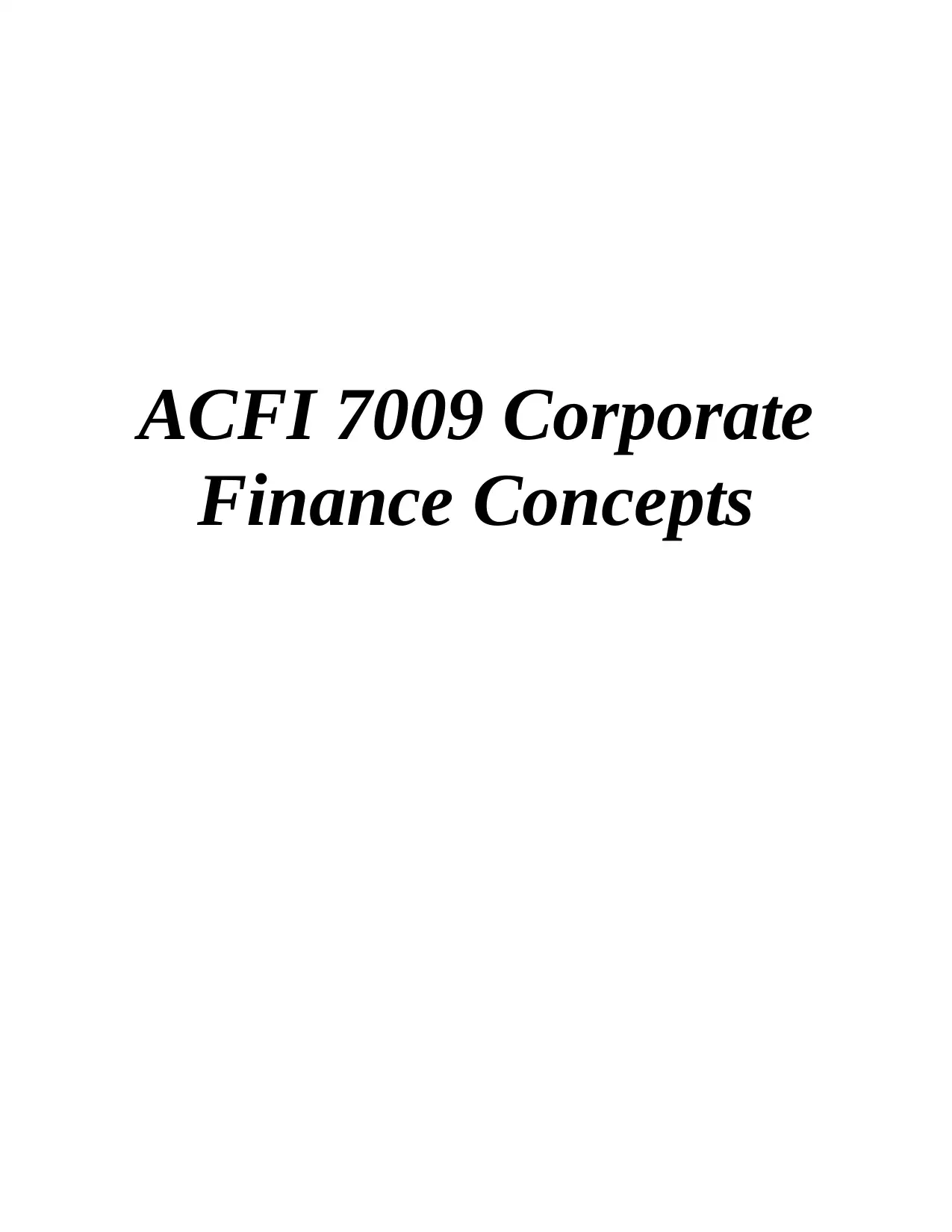
ACFI 7009 Corporate
Finance Concepts
Finance Concepts
Paraphrase This Document
Need a fresh take? Get an instant paraphrase of this document with our AI Paraphraser
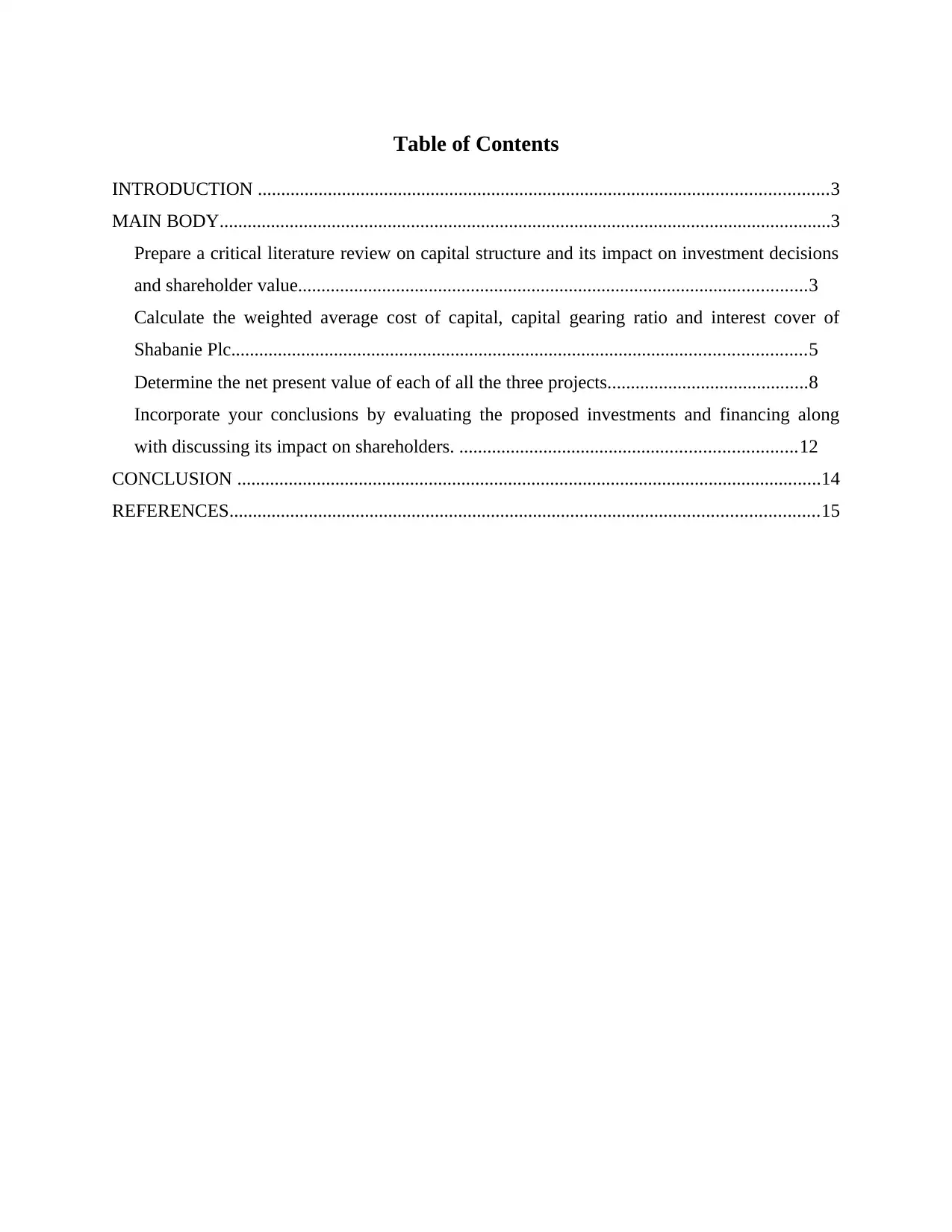
Table of Contents
INTRODUCTION ..........................................................................................................................3
MAIN BODY...................................................................................................................................3
Prepare a critical literature review on capital structure and its impact on investment decisions
and shareholder value.............................................................................................................3
Calculate the weighted average cost of capital, capital gearing ratio and interest cover of
Shabanie Plc...........................................................................................................................5
Determine the net present value of each of all the three projects...........................................8
Incorporate your conclusions by evaluating the proposed investments and financing along
with discussing its impact on shareholders. ........................................................................12
CONCLUSION .............................................................................................................................14
REFERENCES..............................................................................................................................15
INTRODUCTION ..........................................................................................................................3
MAIN BODY...................................................................................................................................3
Prepare a critical literature review on capital structure and its impact on investment decisions
and shareholder value.............................................................................................................3
Calculate the weighted average cost of capital, capital gearing ratio and interest cover of
Shabanie Plc...........................................................................................................................5
Determine the net present value of each of all the three projects...........................................8
Incorporate your conclusions by evaluating the proposed investments and financing along
with discussing its impact on shareholders. ........................................................................12
CONCLUSION .............................................................................................................................14
REFERENCES..............................................................................................................................15
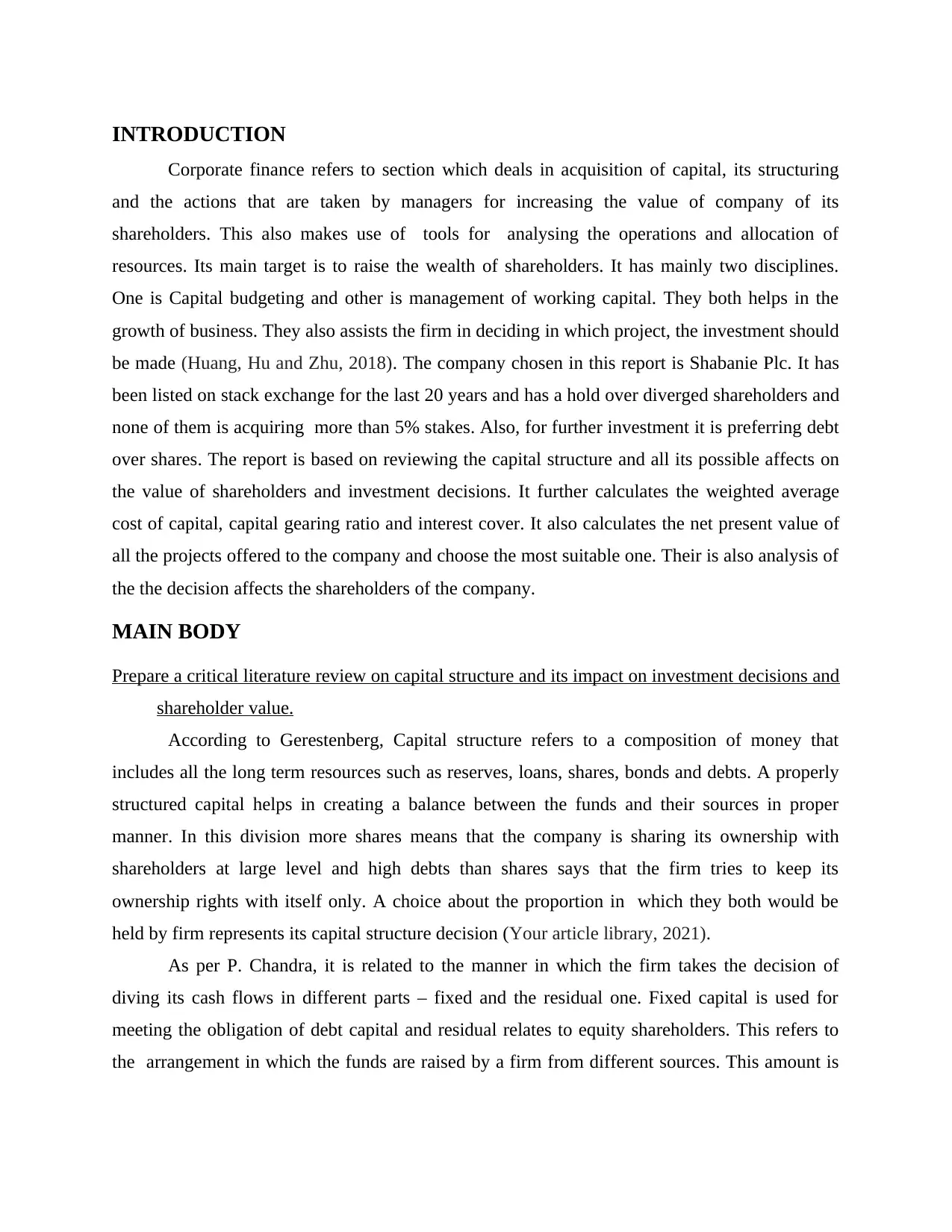
INTRODUCTION
Corporate finance refers to section which deals in acquisition of capital, its structuring
and the actions that are taken by managers for increasing the value of company of its
shareholders. This also makes use of tools for analysing the operations and allocation of
resources. Its main target is to raise the wealth of shareholders. It has mainly two disciplines.
One is Capital budgeting and other is management of working capital. They both helps in the
growth of business. They also assists the firm in deciding in which project, the investment should
be made (Huang, Hu and Zhu, 2018). The company chosen in this report is Shabanie Plc. It has
been listed on stack exchange for the last 20 years and has a hold over diverged shareholders and
none of them is acquiring more than 5% stakes. Also, for further investment it is preferring debt
over shares. The report is based on reviewing the capital structure and all its possible affects on
the value of shareholders and investment decisions. It further calculates the weighted average
cost of capital, capital gearing ratio and interest cover. It also calculates the net present value of
all the projects offered to the company and choose the most suitable one. Their is also analysis of
the the decision affects the shareholders of the company.
MAIN BODY
Prepare a critical literature review on capital structure and its impact on investment decisions and
shareholder value.
According to Gerestenberg, Capital structure refers to a composition of money that
includes all the long term resources such as reserves, loans, shares, bonds and debts. A properly
structured capital helps in creating a balance between the funds and their sources in proper
manner. In this division more shares means that the company is sharing its ownership with
shareholders at large level and high debts than shares says that the firm tries to keep its
ownership rights with itself only. A choice about the proportion in which they both would be
held by firm represents its capital structure decision (Your article library, 2021).
As per P. Chandra, it is related to the manner in which the firm takes the decision of
diving its cash flows in different parts – fixed and the residual one. Fixed capital is used for
meeting the obligation of debt capital and residual relates to equity shareholders. This refers to
the arrangement in which the funds are raised by a firm from different sources. This amount is
Corporate finance refers to section which deals in acquisition of capital, its structuring
and the actions that are taken by managers for increasing the value of company of its
shareholders. This also makes use of tools for analysing the operations and allocation of
resources. Its main target is to raise the wealth of shareholders. It has mainly two disciplines.
One is Capital budgeting and other is management of working capital. They both helps in the
growth of business. They also assists the firm in deciding in which project, the investment should
be made (Huang, Hu and Zhu, 2018). The company chosen in this report is Shabanie Plc. It has
been listed on stack exchange for the last 20 years and has a hold over diverged shareholders and
none of them is acquiring more than 5% stakes. Also, for further investment it is preferring debt
over shares. The report is based on reviewing the capital structure and all its possible affects on
the value of shareholders and investment decisions. It further calculates the weighted average
cost of capital, capital gearing ratio and interest cover. It also calculates the net present value of
all the projects offered to the company and choose the most suitable one. Their is also analysis of
the the decision affects the shareholders of the company.
MAIN BODY
Prepare a critical literature review on capital structure and its impact on investment decisions and
shareholder value.
According to Gerestenberg, Capital structure refers to a composition of money that
includes all the long term resources such as reserves, loans, shares, bonds and debts. A properly
structured capital helps in creating a balance between the funds and their sources in proper
manner. In this division more shares means that the company is sharing its ownership with
shareholders at large level and high debts than shares says that the firm tries to keep its
ownership rights with itself only. A choice about the proportion in which they both would be
held by firm represents its capital structure decision (Your article library, 2021).
As per P. Chandra, it is related to the manner in which the firm takes the decision of
diving its cash flows in different parts – fixed and the residual one. Fixed capital is used for
meeting the obligation of debt capital and residual relates to equity shareholders. This refers to
the arrangement in which the funds are raised by a firm from different sources. This amount is
⊘ This is a preview!⊘
Do you want full access?
Subscribe today to unlock all pages.

Trusted by 1+ million students worldwide
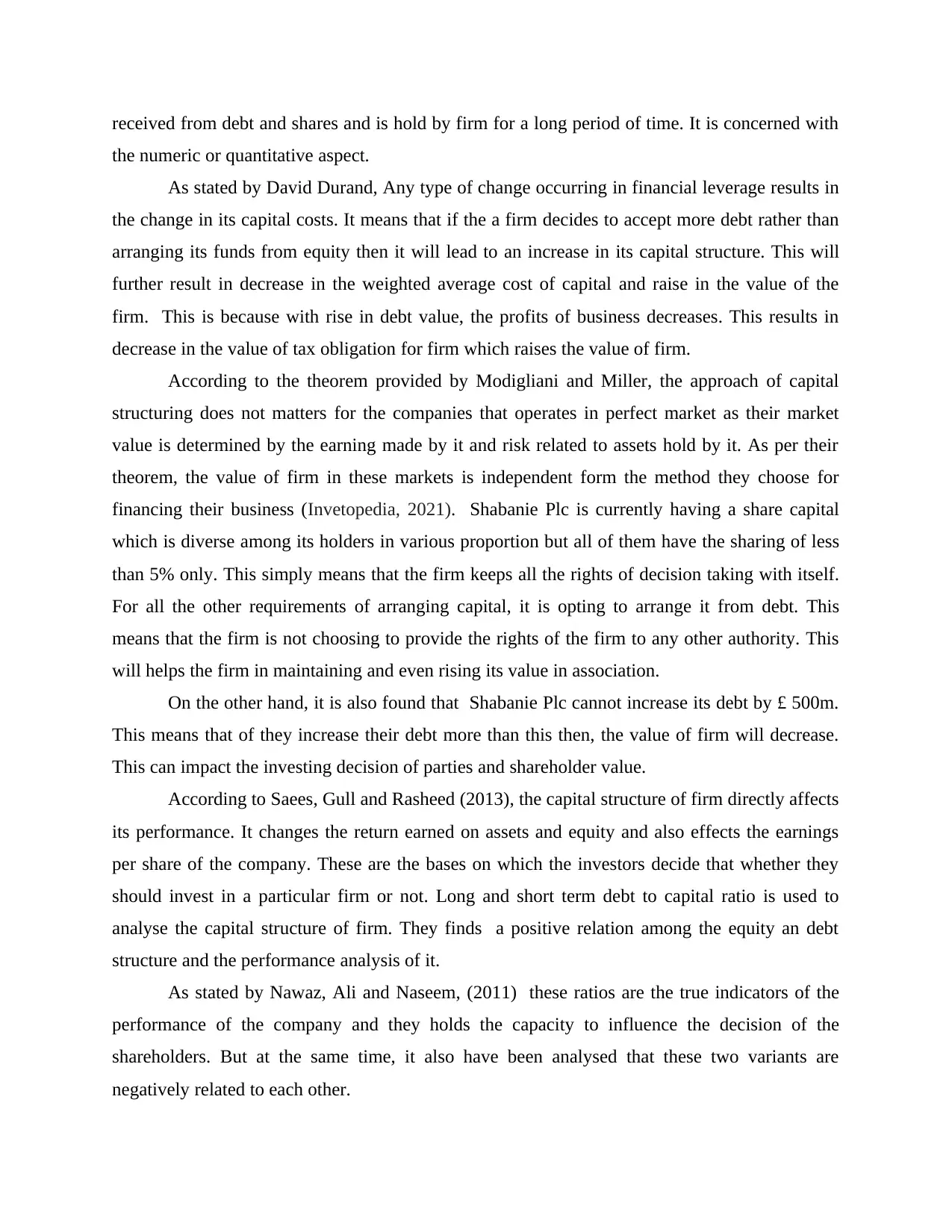
received from debt and shares and is hold by firm for a long period of time. It is concerned with
the numeric or quantitative aspect.
As stated by David Durand, Any type of change occurring in financial leverage results in
the change in its capital costs. It means that if the a firm decides to accept more debt rather than
arranging its funds from equity then it will lead to an increase in its capital structure. This will
further result in decrease in the weighted average cost of capital and raise in the value of the
firm. This is because with rise in debt value, the profits of business decreases. This results in
decrease in the value of tax obligation for firm which raises the value of firm.
According to the theorem provided by Modigliani and Miller, the approach of capital
structuring does not matters for the companies that operates in perfect market as their market
value is determined by the earning made by it and risk related to assets hold by it. As per their
theorem, the value of firm in these markets is independent form the method they choose for
financing their business (Invetopedia, 2021). Shabanie Plc is currently having a share capital
which is diverse among its holders in various proportion but all of them have the sharing of less
than 5% only. This simply means that the firm keeps all the rights of decision taking with itself.
For all the other requirements of arranging capital, it is opting to arrange it from debt. This
means that the firm is not choosing to provide the rights of the firm to any other authority. This
will helps the firm in maintaining and even rising its value in association.
On the other hand, it is also found that Shabanie Plc cannot increase its debt by £ 500m.
This means that of they increase their debt more than this then, the value of firm will decrease.
This can impact the investing decision of parties and shareholder value.
According to Saees, Gull and Rasheed (2013), the capital structure of firm directly affects
its performance. It changes the return earned on assets and equity and also effects the earnings
per share of the company. These are the bases on which the investors decide that whether they
should invest in a particular firm or not. Long and short term debt to capital ratio is used to
analyse the capital structure of firm. They finds a positive relation among the equity an debt
structure and the performance analysis of it.
As stated by Nawaz, Ali and Naseem, (2011) these ratios are the true indicators of the
performance of the company and they holds the capacity to influence the decision of the
shareholders. But at the same time, it also have been analysed that these two variants are
negatively related to each other.
the numeric or quantitative aspect.
As stated by David Durand, Any type of change occurring in financial leverage results in
the change in its capital costs. It means that if the a firm decides to accept more debt rather than
arranging its funds from equity then it will lead to an increase in its capital structure. This will
further result in decrease in the weighted average cost of capital and raise in the value of the
firm. This is because with rise in debt value, the profits of business decreases. This results in
decrease in the value of tax obligation for firm which raises the value of firm.
According to the theorem provided by Modigliani and Miller, the approach of capital
structuring does not matters for the companies that operates in perfect market as their market
value is determined by the earning made by it and risk related to assets hold by it. As per their
theorem, the value of firm in these markets is independent form the method they choose for
financing their business (Invetopedia, 2021). Shabanie Plc is currently having a share capital
which is diverse among its holders in various proportion but all of them have the sharing of less
than 5% only. This simply means that the firm keeps all the rights of decision taking with itself.
For all the other requirements of arranging capital, it is opting to arrange it from debt. This
means that the firm is not choosing to provide the rights of the firm to any other authority. This
will helps the firm in maintaining and even rising its value in association.
On the other hand, it is also found that Shabanie Plc cannot increase its debt by £ 500m.
This means that of they increase their debt more than this then, the value of firm will decrease.
This can impact the investing decision of parties and shareholder value.
According to Saees, Gull and Rasheed (2013), the capital structure of firm directly affects
its performance. It changes the return earned on assets and equity and also effects the earnings
per share of the company. These are the bases on which the investors decide that whether they
should invest in a particular firm or not. Long and short term debt to capital ratio is used to
analyse the capital structure of firm. They finds a positive relation among the equity an debt
structure and the performance analysis of it.
As stated by Nawaz, Ali and Naseem, (2011) these ratios are the true indicators of the
performance of the company and they holds the capacity to influence the decision of the
shareholders. But at the same time, it also have been analysed that these two variants are
negatively related to each other.
Paraphrase This Document
Need a fresh take? Get an instant paraphrase of this document with our AI Paraphraser
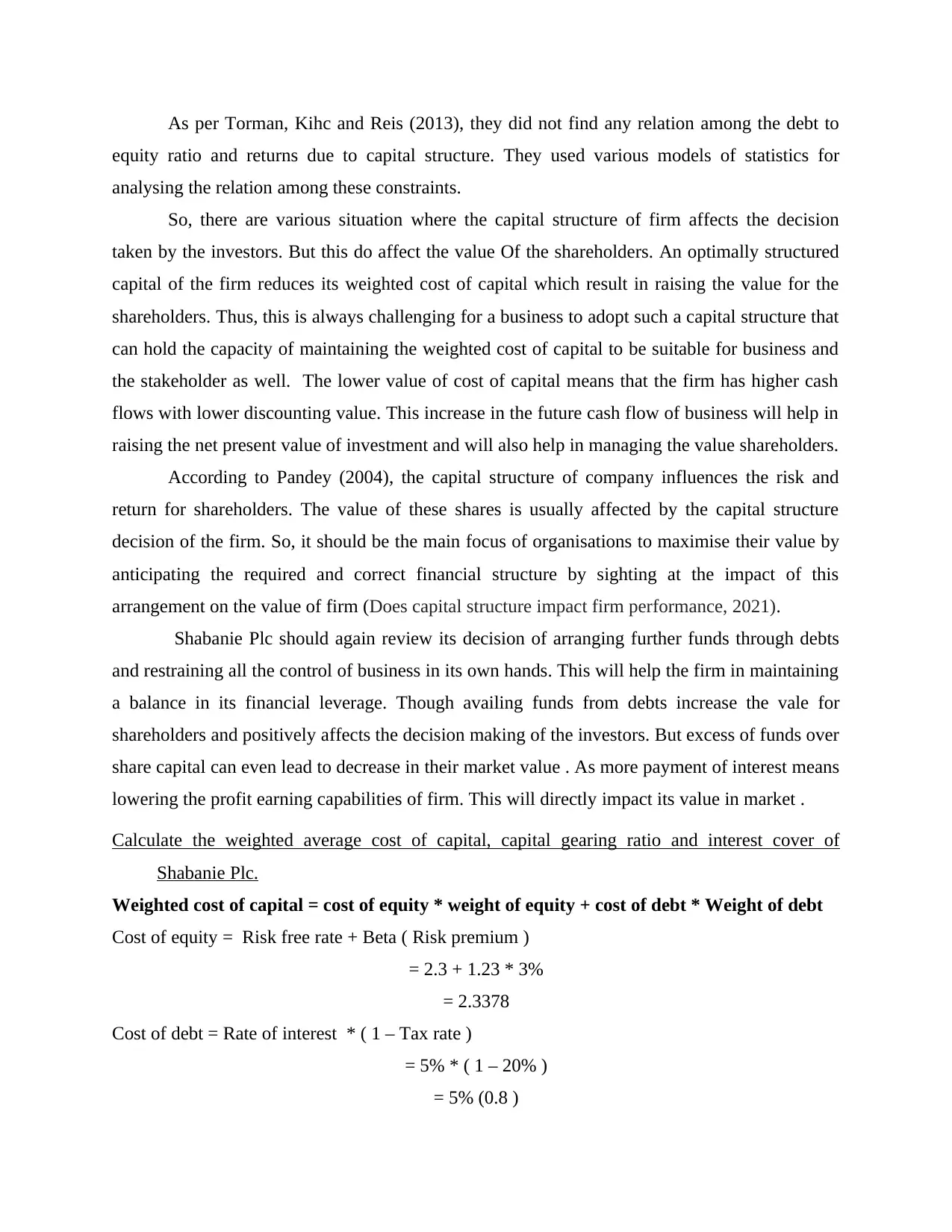
As per Torman, Kihc and Reis (2013), they did not find any relation among the debt to
equity ratio and returns due to capital structure. They used various models of statistics for
analysing the relation among these constraints.
So, there are various situation where the capital structure of firm affects the decision
taken by the investors. But this do affect the value Of the shareholders. An optimally structured
capital of the firm reduces its weighted cost of capital which result in raising the value for the
shareholders. Thus, this is always challenging for a business to adopt such a capital structure that
can hold the capacity of maintaining the weighted cost of capital to be suitable for business and
the stakeholder as well. The lower value of cost of capital means that the firm has higher cash
flows with lower discounting value. This increase in the future cash flow of business will help in
raising the net present value of investment and will also help in managing the value shareholders.
According to Pandey (2004), the capital structure of company influences the risk and
return for shareholders. The value of these shares is usually affected by the capital structure
decision of the firm. So, it should be the main focus of organisations to maximise their value by
anticipating the required and correct financial structure by sighting at the impact of this
arrangement on the value of firm (Does capital structure impact firm performance, 2021).
Shabanie Plc should again review its decision of arranging further funds through debts
and restraining all the control of business in its own hands. This will help the firm in maintaining
a balance in its financial leverage. Though availing funds from debts increase the vale for
shareholders and positively affects the decision making of the investors. But excess of funds over
share capital can even lead to decrease in their market value . As more payment of interest means
lowering the profit earning capabilities of firm. This will directly impact its value in market .
Calculate the weighted average cost of capital, capital gearing ratio and interest cover of
Shabanie Plc.
Weighted cost of capital = cost of equity * weight of equity + cost of debt * Weight of debt
Cost of equity = Risk free rate + Beta ( Risk premium )
= 2.3 + 1.23 * 3%
= 2.3378
Cost of debt = Rate of interest * ( 1 – Tax rate )
= 5% * ( 1 – 20% )
= 5% (0.8 )
equity ratio and returns due to capital structure. They used various models of statistics for
analysing the relation among these constraints.
So, there are various situation where the capital structure of firm affects the decision
taken by the investors. But this do affect the value Of the shareholders. An optimally structured
capital of the firm reduces its weighted cost of capital which result in raising the value for the
shareholders. Thus, this is always challenging for a business to adopt such a capital structure that
can hold the capacity of maintaining the weighted cost of capital to be suitable for business and
the stakeholder as well. The lower value of cost of capital means that the firm has higher cash
flows with lower discounting value. This increase in the future cash flow of business will help in
raising the net present value of investment and will also help in managing the value shareholders.
According to Pandey (2004), the capital structure of company influences the risk and
return for shareholders. The value of these shares is usually affected by the capital structure
decision of the firm. So, it should be the main focus of organisations to maximise their value by
anticipating the required and correct financial structure by sighting at the impact of this
arrangement on the value of firm (Does capital structure impact firm performance, 2021).
Shabanie Plc should again review its decision of arranging further funds through debts
and restraining all the control of business in its own hands. This will help the firm in maintaining
a balance in its financial leverage. Though availing funds from debts increase the vale for
shareholders and positively affects the decision making of the investors. But excess of funds over
share capital can even lead to decrease in their market value . As more payment of interest means
lowering the profit earning capabilities of firm. This will directly impact its value in market .
Calculate the weighted average cost of capital, capital gearing ratio and interest cover of
Shabanie Plc.
Weighted cost of capital = cost of equity * weight of equity + cost of debt * Weight of debt
Cost of equity = Risk free rate + Beta ( Risk premium )
= 2.3 + 1.23 * 3%
= 2.3378
Cost of debt = Rate of interest * ( 1 – Tax rate )
= 5% * ( 1 – 20% )
= 5% (0.8 )
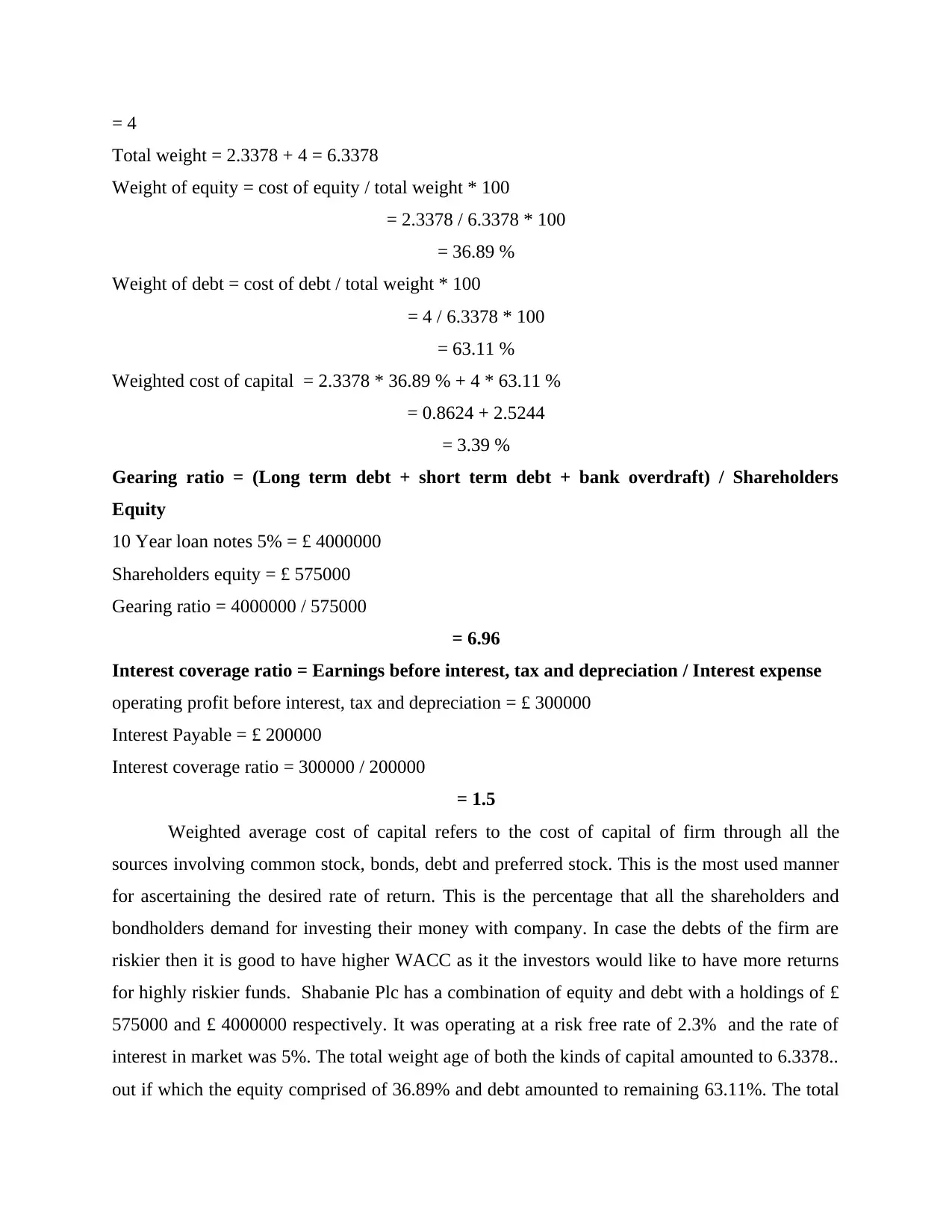
= 4
Total weight = 2.3378 + 4 = 6.3378
Weight of equity = cost of equity / total weight * 100
= 2.3378 / 6.3378 * 100
= 36.89 %
Weight of debt = cost of debt / total weight * 100
= 4 / 6.3378 * 100
= 63.11 %
Weighted cost of capital = 2.3378 * 36.89 % + 4 * 63.11 %
= 0.8624 + 2.5244
= 3.39 %
Gearing ratio = (Long term debt + short term debt + bank overdraft) / Shareholders
Equity
10 Year loan notes 5% = £ 4000000
Shareholders equity = £ 575000
Gearing ratio = 4000000 / 575000
= 6.96
Interest coverage ratio = Earnings before interest, tax and depreciation / Interest expense
operating profit before interest, tax and depreciation = £ 300000
Interest Payable = £ 200000
Interest coverage ratio = 300000 / 200000
= 1.5
Weighted average cost of capital refers to the cost of capital of firm through all the
sources involving common stock, bonds, debt and preferred stock. This is the most used manner
for ascertaining the desired rate of return. This is the percentage that all the shareholders and
bondholders demand for investing their money with company. In case the debts of the firm are
riskier then it is good to have higher WACC as it the investors would like to have more returns
for highly riskier funds. Shabanie Plc has a combination of equity and debt with a holdings of £
575000 and £ 4000000 respectively. It was operating at a risk free rate of 2.3% and the rate of
interest in market was 5%. The total weight age of both the kinds of capital amounted to 6.3378..
out if which the equity comprised of 36.89% and debt amounted to remaining 63.11%. The total
Total weight = 2.3378 + 4 = 6.3378
Weight of equity = cost of equity / total weight * 100
= 2.3378 / 6.3378 * 100
= 36.89 %
Weight of debt = cost of debt / total weight * 100
= 4 / 6.3378 * 100
= 63.11 %
Weighted cost of capital = 2.3378 * 36.89 % + 4 * 63.11 %
= 0.8624 + 2.5244
= 3.39 %
Gearing ratio = (Long term debt + short term debt + bank overdraft) / Shareholders
Equity
10 Year loan notes 5% = £ 4000000
Shareholders equity = £ 575000
Gearing ratio = 4000000 / 575000
= 6.96
Interest coverage ratio = Earnings before interest, tax and depreciation / Interest expense
operating profit before interest, tax and depreciation = £ 300000
Interest Payable = £ 200000
Interest coverage ratio = 300000 / 200000
= 1.5
Weighted average cost of capital refers to the cost of capital of firm through all the
sources involving common stock, bonds, debt and preferred stock. This is the most used manner
for ascertaining the desired rate of return. This is the percentage that all the shareholders and
bondholders demand for investing their money with company. In case the debts of the firm are
riskier then it is good to have higher WACC as it the investors would like to have more returns
for highly riskier funds. Shabanie Plc has a combination of equity and debt with a holdings of £
575000 and £ 4000000 respectively. It was operating at a risk free rate of 2.3% and the rate of
interest in market was 5%. The total weight age of both the kinds of capital amounted to 6.3378..
out if which the equity comprised of 36.89% and debt amounted to remaining 63.11%. The total
⊘ This is a preview!⊘
Do you want full access?
Subscribe today to unlock all pages.

Trusted by 1+ million students worldwide
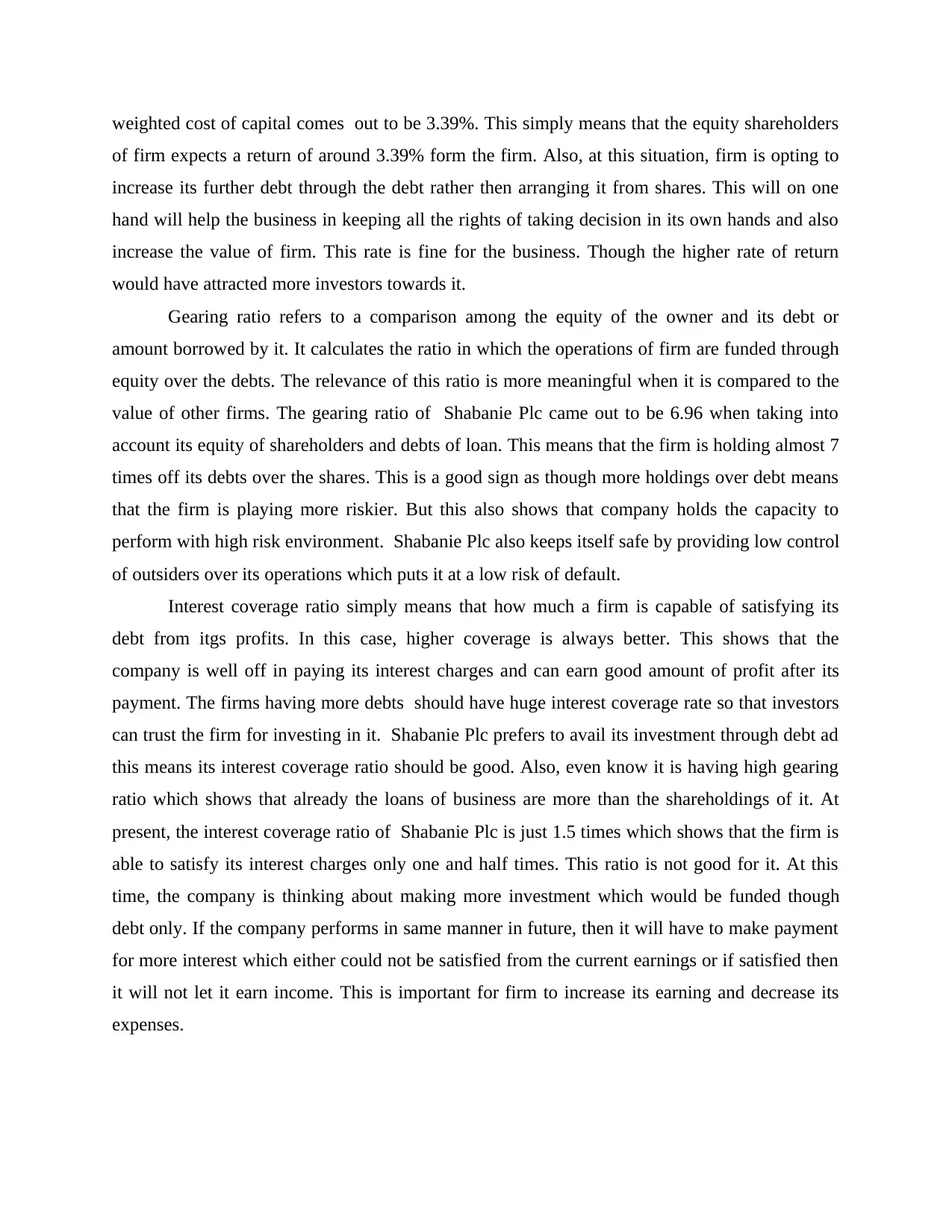
weighted cost of capital comes out to be 3.39%. This simply means that the equity shareholders
of firm expects a return of around 3.39% form the firm. Also, at this situation, firm is opting to
increase its further debt through the debt rather then arranging it from shares. This will on one
hand will help the business in keeping all the rights of taking decision in its own hands and also
increase the value of firm. This rate is fine for the business. Though the higher rate of return
would have attracted more investors towards it.
Gearing ratio refers to a comparison among the equity of the owner and its debt or
amount borrowed by it. It calculates the ratio in which the operations of firm are funded through
equity over the debts. The relevance of this ratio is more meaningful when it is compared to the
value of other firms. The gearing ratio of Shabanie Plc came out to be 6.96 when taking into
account its equity of shareholders and debts of loan. This means that the firm is holding almost 7
times off its debts over the shares. This is a good sign as though more holdings over debt means
that the firm is playing more riskier. But this also shows that company holds the capacity to
perform with high risk environment. Shabanie Plc also keeps itself safe by providing low control
of outsiders over its operations which puts it at a low risk of default.
Interest coverage ratio simply means that how much a firm is capable of satisfying its
debt from itgs profits. In this case, higher coverage is always better. This shows that the
company is well off in paying its interest charges and can earn good amount of profit after its
payment. The firms having more debts should have huge interest coverage rate so that investors
can trust the firm for investing in it. Shabanie Plc prefers to avail its investment through debt ad
this means its interest coverage ratio should be good. Also, even know it is having high gearing
ratio which shows that already the loans of business are more than the shareholdings of it. At
present, the interest coverage ratio of Shabanie Plc is just 1.5 times which shows that the firm is
able to satisfy its interest charges only one and half times. This ratio is not good for it. At this
time, the company is thinking about making more investment which would be funded though
debt only. If the company performs in same manner in future, then it will have to make payment
for more interest which either could not be satisfied from the current earnings or if satisfied then
it will not let it earn income. This is important for firm to increase its earning and decrease its
expenses.
of firm expects a return of around 3.39% form the firm. Also, at this situation, firm is opting to
increase its further debt through the debt rather then arranging it from shares. This will on one
hand will help the business in keeping all the rights of taking decision in its own hands and also
increase the value of firm. This rate is fine for the business. Though the higher rate of return
would have attracted more investors towards it.
Gearing ratio refers to a comparison among the equity of the owner and its debt or
amount borrowed by it. It calculates the ratio in which the operations of firm are funded through
equity over the debts. The relevance of this ratio is more meaningful when it is compared to the
value of other firms. The gearing ratio of Shabanie Plc came out to be 6.96 when taking into
account its equity of shareholders and debts of loan. This means that the firm is holding almost 7
times off its debts over the shares. This is a good sign as though more holdings over debt means
that the firm is playing more riskier. But this also shows that company holds the capacity to
perform with high risk environment. Shabanie Plc also keeps itself safe by providing low control
of outsiders over its operations which puts it at a low risk of default.
Interest coverage ratio simply means that how much a firm is capable of satisfying its
debt from itgs profits. In this case, higher coverage is always better. This shows that the
company is well off in paying its interest charges and can earn good amount of profit after its
payment. The firms having more debts should have huge interest coverage rate so that investors
can trust the firm for investing in it. Shabanie Plc prefers to avail its investment through debt ad
this means its interest coverage ratio should be good. Also, even know it is having high gearing
ratio which shows that already the loans of business are more than the shareholdings of it. At
present, the interest coverage ratio of Shabanie Plc is just 1.5 times which shows that the firm is
able to satisfy its interest charges only one and half times. This ratio is not good for it. At this
time, the company is thinking about making more investment which would be funded though
debt only. If the company performs in same manner in future, then it will have to make payment
for more interest which either could not be satisfied from the current earnings or if satisfied then
it will not let it earn income. This is important for firm to increase its earning and decrease its
expenses.
Paraphrase This Document
Need a fresh take? Get an instant paraphrase of this document with our AI Paraphraser
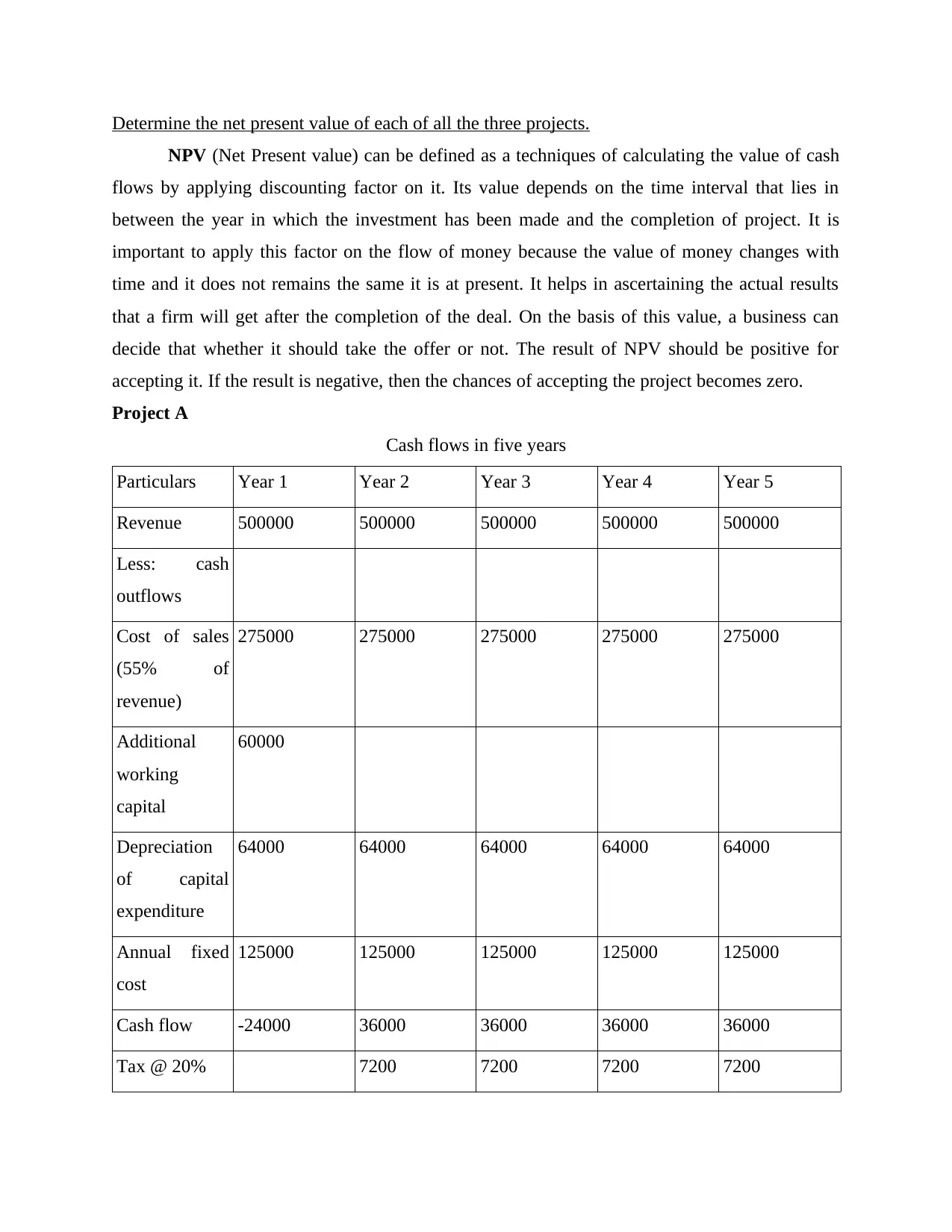
Determine the net present value of each of all the three projects.
NPV (Net Present value) can be defined as a techniques of calculating the value of cash
flows by applying discounting factor on it. Its value depends on the time interval that lies in
between the year in which the investment has been made and the completion of project. It is
important to apply this factor on the flow of money because the value of money changes with
time and it does not remains the same it is at present. It helps in ascertaining the actual results
that a firm will get after the completion of the deal. On the basis of this value, a business can
decide that whether it should take the offer or not. The result of NPV should be positive for
accepting it. If the result is negative, then the chances of accepting the project becomes zero.
Project A
Cash flows in five years
Particulars Year 1 Year 2 Year 3 Year 4 Year 5
Revenue 500000 500000 500000 500000 500000
Less: cash
outflows
Cost of sales
(55% of
revenue)
275000 275000 275000 275000 275000
Additional
working
capital
60000
Depreciation
of capital
expenditure
64000 64000 64000 64000 64000
Annual fixed
cost
125000 125000 125000 125000 125000
Cash flow -24000 36000 36000 36000 36000
Tax @ 20% 7200 7200 7200 7200
NPV (Net Present value) can be defined as a techniques of calculating the value of cash
flows by applying discounting factor on it. Its value depends on the time interval that lies in
between the year in which the investment has been made and the completion of project. It is
important to apply this factor on the flow of money because the value of money changes with
time and it does not remains the same it is at present. It helps in ascertaining the actual results
that a firm will get after the completion of the deal. On the basis of this value, a business can
decide that whether it should take the offer or not. The result of NPV should be positive for
accepting it. If the result is negative, then the chances of accepting the project becomes zero.
Project A
Cash flows in five years
Particulars Year 1 Year 2 Year 3 Year 4 Year 5
Revenue 500000 500000 500000 500000 500000
Less: cash
outflows
Cost of sales
(55% of
revenue)
275000 275000 275000 275000 275000
Additional
working
capital
60000
Depreciation
of capital
expenditure
64000 64000 64000 64000 64000
Annual fixed
cost
125000 125000 125000 125000 125000
Cash flow -24000 36000 36000 36000 36000
Tax @ 20% 7200 7200 7200 7200
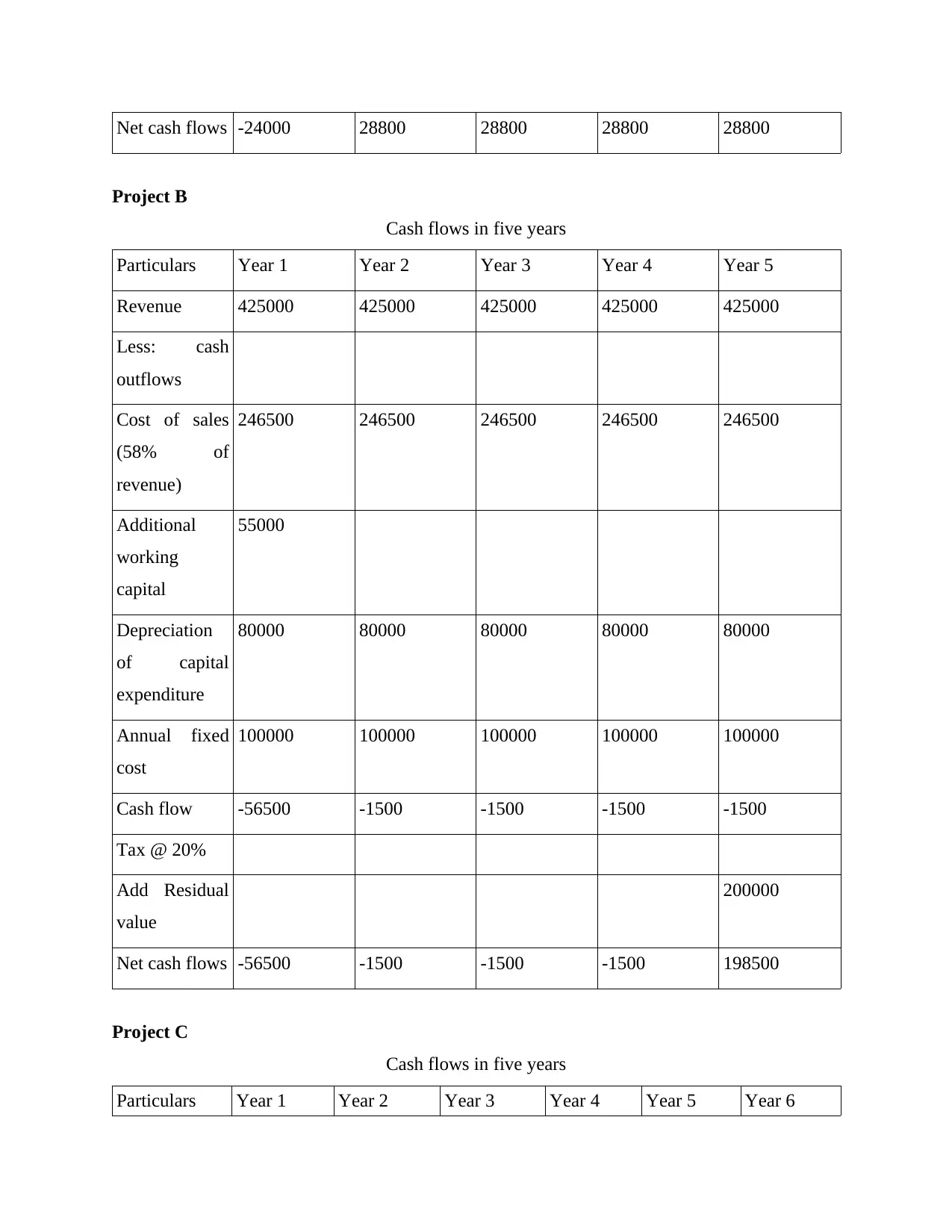
Net cash flows -24000 28800 28800 28800 28800
Project B
Cash flows in five years
Particulars Year 1 Year 2 Year 3 Year 4 Year 5
Revenue 425000 425000 425000 425000 425000
Less: cash
outflows
Cost of sales
(58% of
revenue)
246500 246500 246500 246500 246500
Additional
working
capital
55000
Depreciation
of capital
expenditure
80000 80000 80000 80000 80000
Annual fixed
cost
100000 100000 100000 100000 100000
Cash flow -56500 -1500 -1500 -1500 -1500
Tax @ 20%
Add Residual
value
200000
Net cash flows -56500 -1500 -1500 -1500 198500
Project C
Cash flows in five years
Particulars Year 1 Year 2 Year 3 Year 4 Year 5 Year 6
Project B
Cash flows in five years
Particulars Year 1 Year 2 Year 3 Year 4 Year 5
Revenue 425000 425000 425000 425000 425000
Less: cash
outflows
Cost of sales
(58% of
revenue)
246500 246500 246500 246500 246500
Additional
working
capital
55000
Depreciation
of capital
expenditure
80000 80000 80000 80000 80000
Annual fixed
cost
100000 100000 100000 100000 100000
Cash flow -56500 -1500 -1500 -1500 -1500
Tax @ 20%
Add Residual
value
200000
Net cash flows -56500 -1500 -1500 -1500 198500
Project C
Cash flows in five years
Particulars Year 1 Year 2 Year 3 Year 4 Year 5 Year 6
⊘ This is a preview!⊘
Do you want full access?
Subscribe today to unlock all pages.

Trusted by 1+ million students worldwide
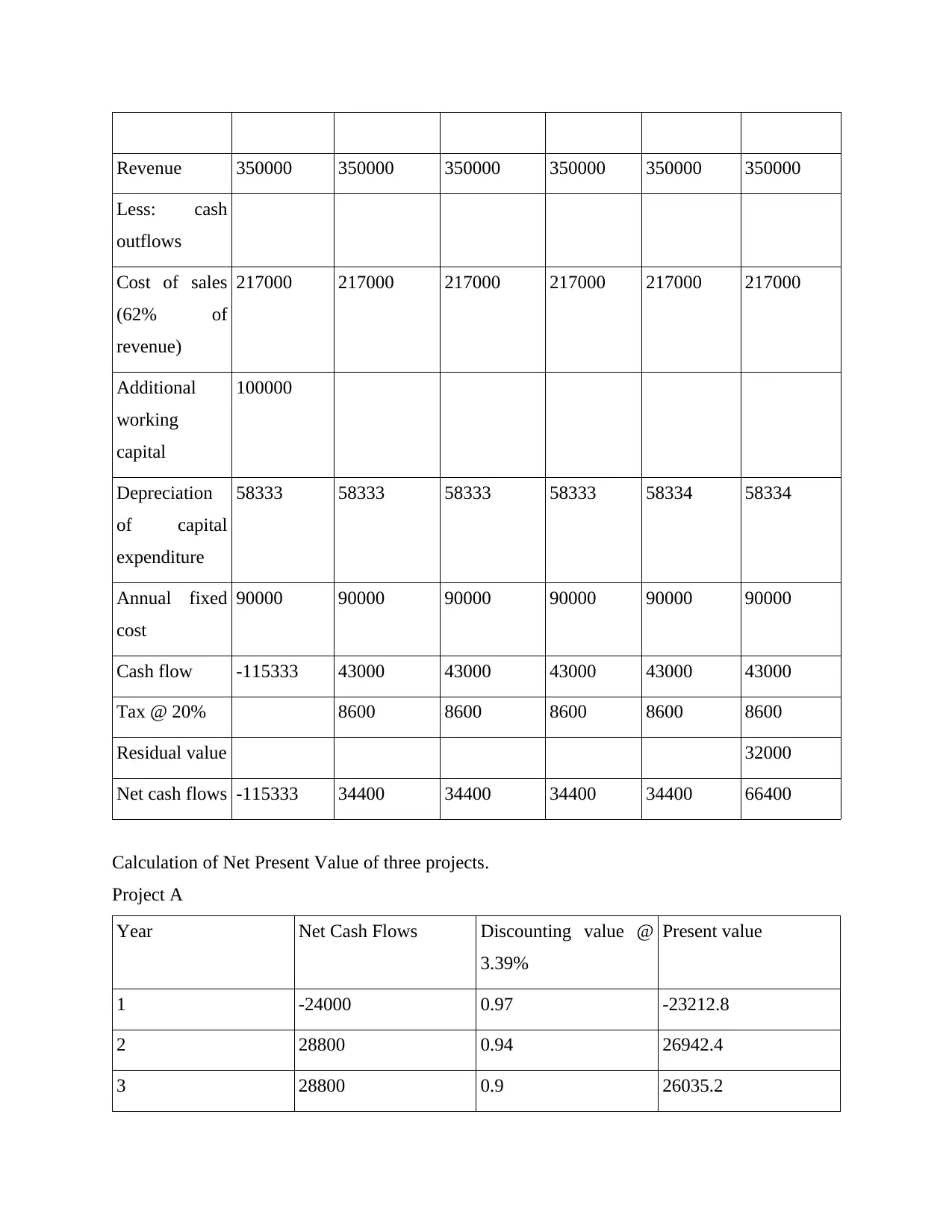
Revenue 350000 350000 350000 350000 350000 350000
Less: cash
outflows
Cost of sales
(62% of
revenue)
217000 217000 217000 217000 217000 217000
Additional
working
capital
100000
Depreciation
of capital
expenditure
58333 58333 58333 58333 58334 58334
Annual fixed
cost
90000 90000 90000 90000 90000 90000
Cash flow -115333 43000 43000 43000 43000 43000
Tax @ 20% 8600 8600 8600 8600 8600
Residual value 32000
Net cash flows -115333 34400 34400 34400 34400 66400
Calculation of Net Present Value of three projects.
Project A
Year Net Cash Flows Discounting value @
3.39%
Present value
1 -24000 0.97 -23212.8
2 28800 0.94 26942.4
3 28800 0.9 26035.2
Less: cash
outflows
Cost of sales
(62% of
revenue)
217000 217000 217000 217000 217000 217000
Additional
working
capital
100000
Depreciation
of capital
expenditure
58333 58333 58333 58333 58334 58334
Annual fixed
cost
90000 90000 90000 90000 90000 90000
Cash flow -115333 43000 43000 43000 43000 43000
Tax @ 20% 8600 8600 8600 8600 8600
Residual value 32000
Net cash flows -115333 34400 34400 34400 34400 66400
Calculation of Net Present Value of three projects.
Project A
Year Net Cash Flows Discounting value @
3.39%
Present value
1 -24000 0.97 -23212.8
2 28800 0.94 26942.4
3 28800 0.9 26035.2
Paraphrase This Document
Need a fresh take? Get an instant paraphrase of this document with our AI Paraphraser
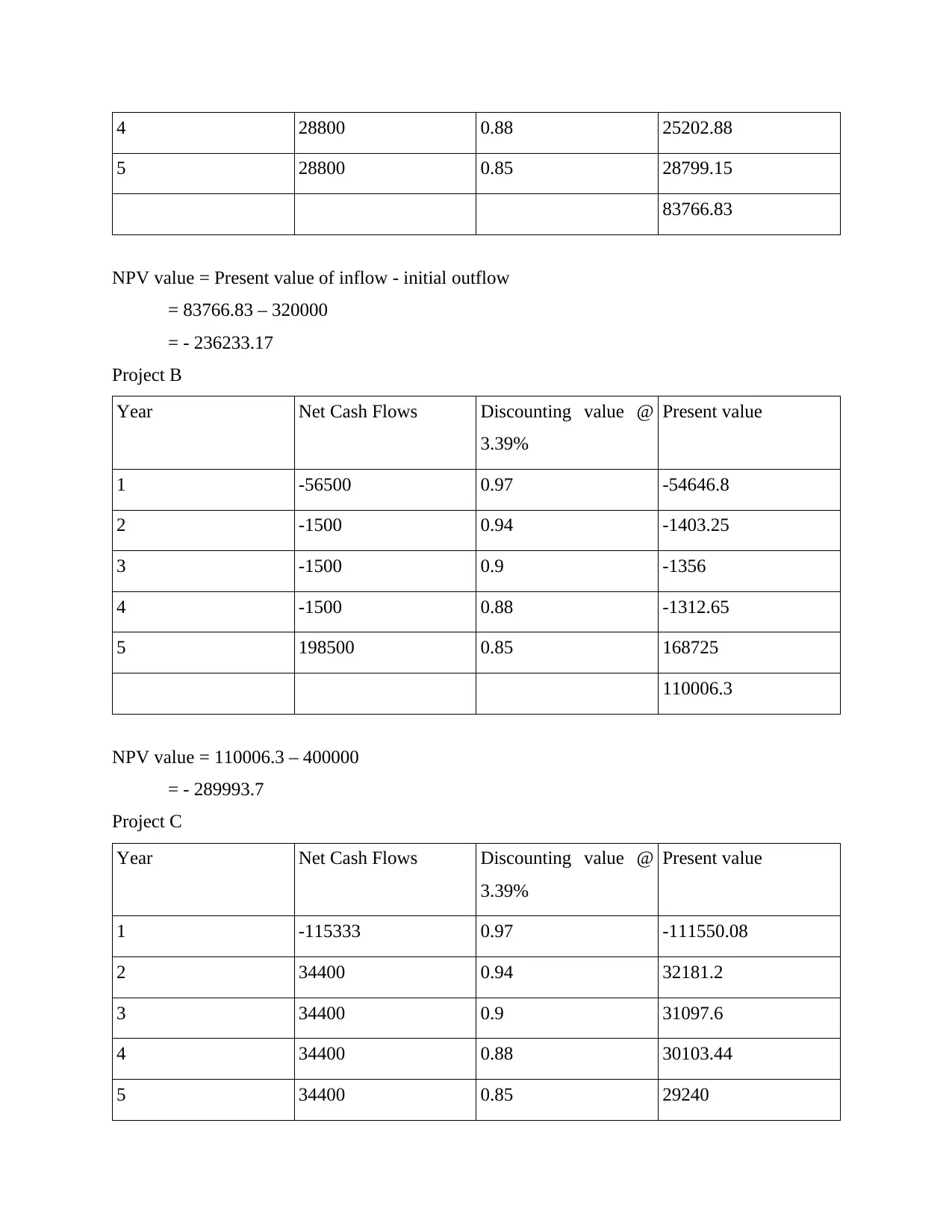
4 28800 0.88 25202.88
5 28800 0.85 28799.15
83766.83
NPV value = Present value of inflow - initial outflow
= 83766.83 – 320000
= - 236233.17
Project B
Year Net Cash Flows Discounting value @
3.39%
Present value
1 -56500 0.97 -54646.8
2 -1500 0.94 -1403.25
3 -1500 0.9 -1356
4 -1500 0.88 -1312.65
5 198500 0.85 168725
110006.3
NPV value = 110006.3 – 400000
= - 289993.7
Project C
Year Net Cash Flows Discounting value @
3.39%
Present value
1 -115333 0.97 -111550.08
2 34400 0.94 32181.2
3 34400 0.9 31097.6
4 34400 0.88 30103.44
5 34400 0.85 29240
5 28800 0.85 28799.15
83766.83
NPV value = Present value of inflow - initial outflow
= 83766.83 – 320000
= - 236233.17
Project B
Year Net Cash Flows Discounting value @
3.39%
Present value
1 -56500 0.97 -54646.8
2 -1500 0.94 -1403.25
3 -1500 0.9 -1356
4 -1500 0.88 -1312.65
5 198500 0.85 168725
110006.3
NPV value = 110006.3 – 400000
= - 289993.7
Project C
Year Net Cash Flows Discounting value @
3.39%
Present value
1 -115333 0.97 -111550.08
2 34400 0.94 32181.2
3 34400 0.9 31097.6
4 34400 0.88 30103.44
5 34400 0.85 29240
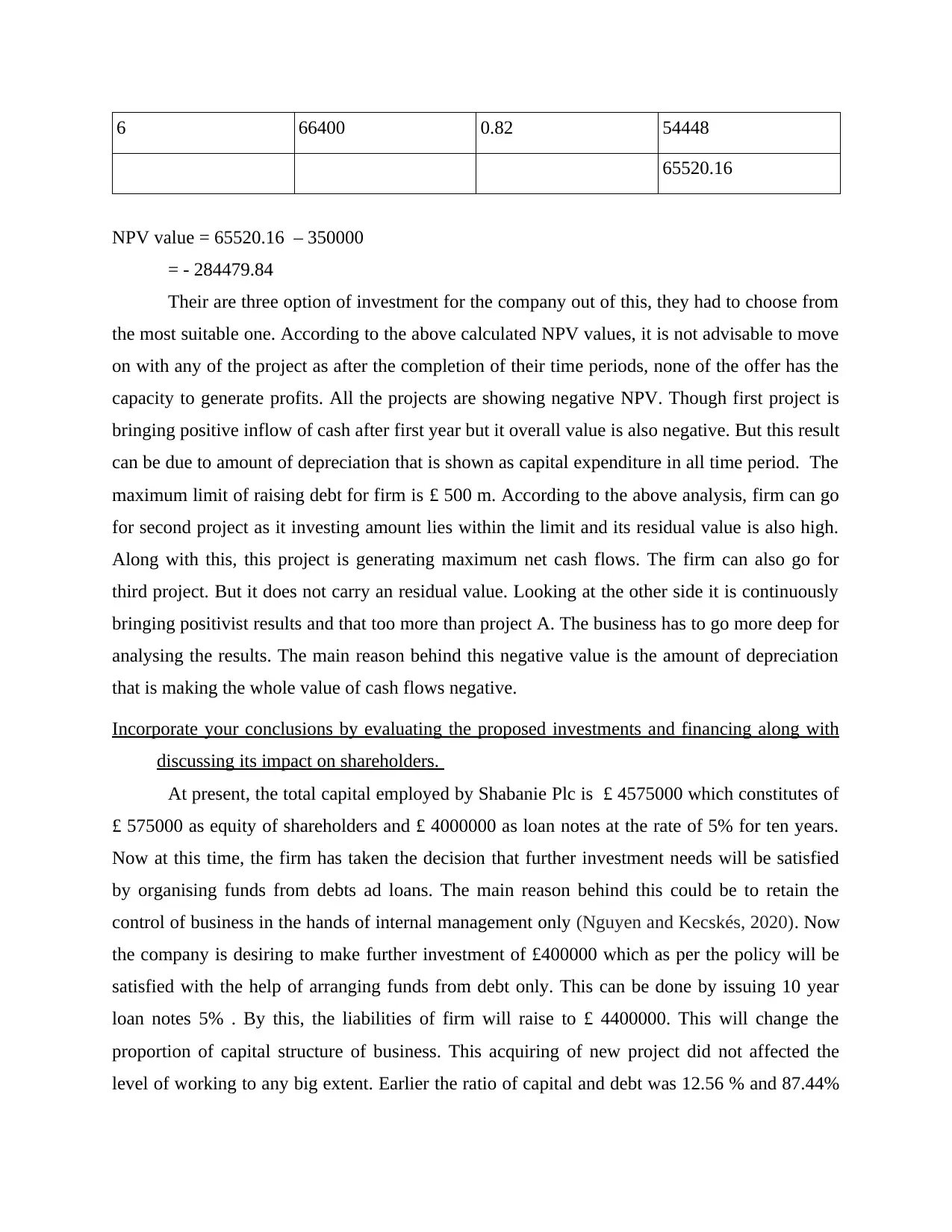
6 66400 0.82 54448
65520.16
NPV value = 65520.16 – 350000
= - 284479.84
Their are three option of investment for the company out of this, they had to choose from
the most suitable one. According to the above calculated NPV values, it is not advisable to move
on with any of the project as after the completion of their time periods, none of the offer has the
capacity to generate profits. All the projects are showing negative NPV. Though first project is
bringing positive inflow of cash after first year but it overall value is also negative. But this result
can be due to amount of depreciation that is shown as capital expenditure in all time period. The
maximum limit of raising debt for firm is £ 500 m. According to the above analysis, firm can go
for second project as it investing amount lies within the limit and its residual value is also high.
Along with this, this project is generating maximum net cash flows. The firm can also go for
third project. But it does not carry an residual value. Looking at the other side it is continuously
bringing positivist results and that too more than project A. The business has to go more deep for
analysing the results. The main reason behind this negative value is the amount of depreciation
that is making the whole value of cash flows negative.
Incorporate your conclusions by evaluating the proposed investments and financing along with
discussing its impact on shareholders.
At present, the total capital employed by Shabanie Plc is £ 4575000 which constitutes of
£ 575000 as equity of shareholders and £ 4000000 as loan notes at the rate of 5% for ten years.
Now at this time, the firm has taken the decision that further investment needs will be satisfied
by organising funds from debts ad loans. The main reason behind this could be to retain the
control of business in the hands of internal management only (Nguyen and Kecskés, 2020). Now
the company is desiring to make further investment of £400000 which as per the policy will be
satisfied with the help of arranging funds from debt only. This can be done by issuing 10 year
loan notes 5% . By this, the liabilities of firm will raise to £ 4400000. This will change the
proportion of capital structure of business. This acquiring of new project did not affected the
level of working to any big extent. Earlier the ratio of capital and debt was 12.56 % and 87.44%
65520.16
NPV value = 65520.16 – 350000
= - 284479.84
Their are three option of investment for the company out of this, they had to choose from
the most suitable one. According to the above calculated NPV values, it is not advisable to move
on with any of the project as after the completion of their time periods, none of the offer has the
capacity to generate profits. All the projects are showing negative NPV. Though first project is
bringing positive inflow of cash after first year but it overall value is also negative. But this result
can be due to amount of depreciation that is shown as capital expenditure in all time period. The
maximum limit of raising debt for firm is £ 500 m. According to the above analysis, firm can go
for second project as it investing amount lies within the limit and its residual value is also high.
Along with this, this project is generating maximum net cash flows. The firm can also go for
third project. But it does not carry an residual value. Looking at the other side it is continuously
bringing positivist results and that too more than project A. The business has to go more deep for
analysing the results. The main reason behind this negative value is the amount of depreciation
that is making the whole value of cash flows negative.
Incorporate your conclusions by evaluating the proposed investments and financing along with
discussing its impact on shareholders.
At present, the total capital employed by Shabanie Plc is £ 4575000 which constitutes of
£ 575000 as equity of shareholders and £ 4000000 as loan notes at the rate of 5% for ten years.
Now at this time, the firm has taken the decision that further investment needs will be satisfied
by organising funds from debts ad loans. The main reason behind this could be to retain the
control of business in the hands of internal management only (Nguyen and Kecskés, 2020). Now
the company is desiring to make further investment of £400000 which as per the policy will be
satisfied with the help of arranging funds from debt only. This can be done by issuing 10 year
loan notes 5% . By this, the liabilities of firm will raise to £ 4400000. This will change the
proportion of capital structure of business. This acquiring of new project did not affected the
level of working to any big extent. Earlier the ratio of capital and debt was 12.56 % and 87.44%
⊘ This is a preview!⊘
Do you want full access?
Subscribe today to unlock all pages.

Trusted by 1+ million students worldwide
1 out of 16
Related Documents
Your All-in-One AI-Powered Toolkit for Academic Success.
+13062052269
info@desklib.com
Available 24*7 on WhatsApp / Email
![[object Object]](/_next/static/media/star-bottom.7253800d.svg)
Unlock your academic potential
Copyright © 2020–2025 A2Z Services. All Rights Reserved. Developed and managed by ZUCOL.





